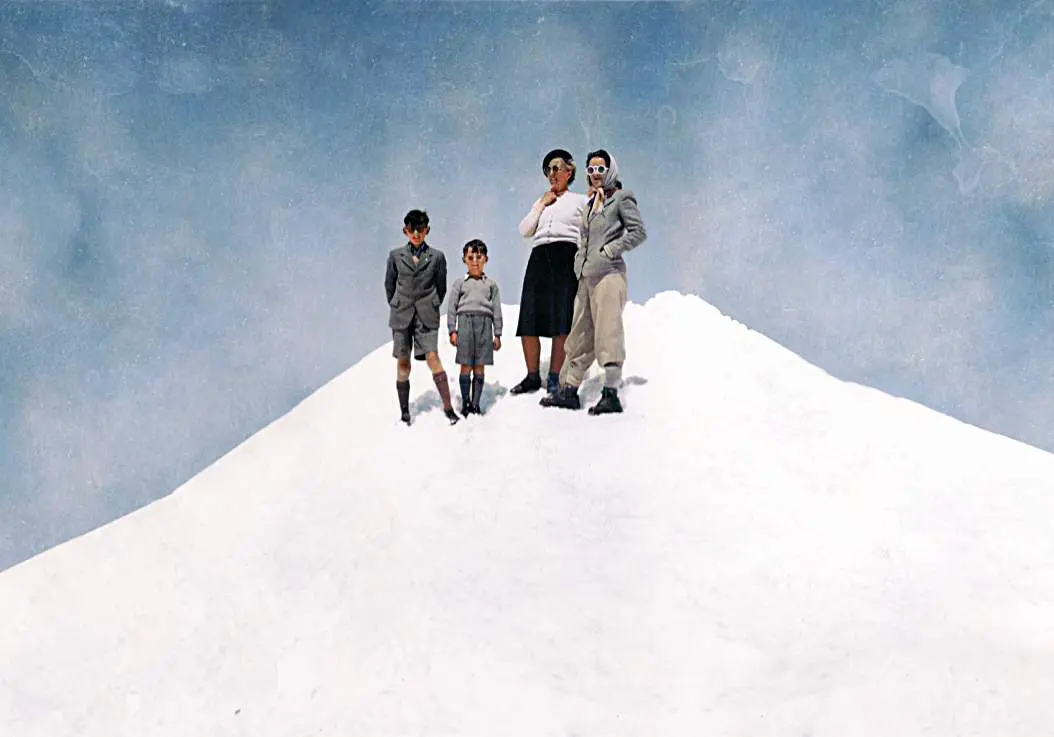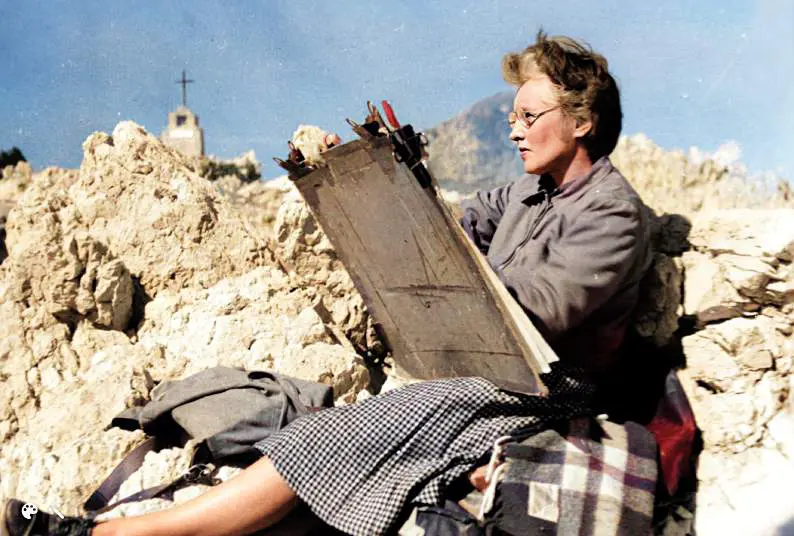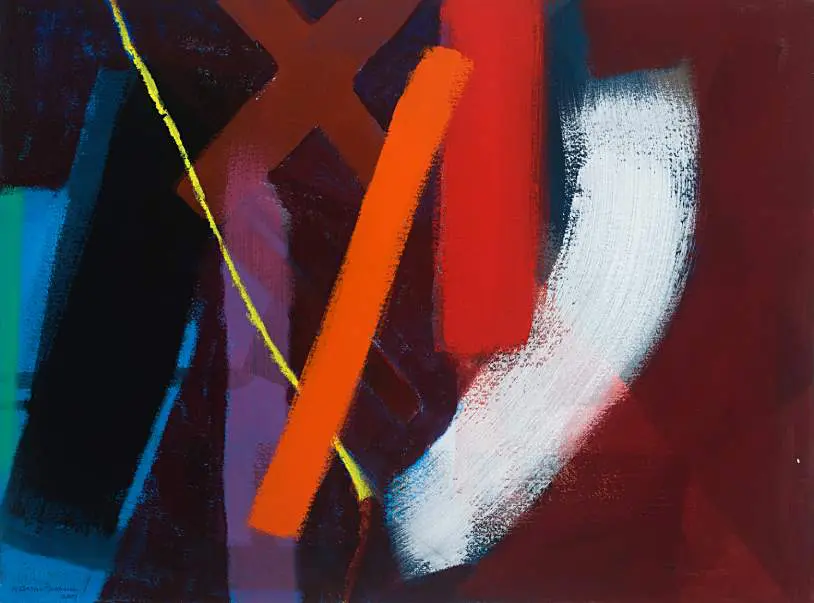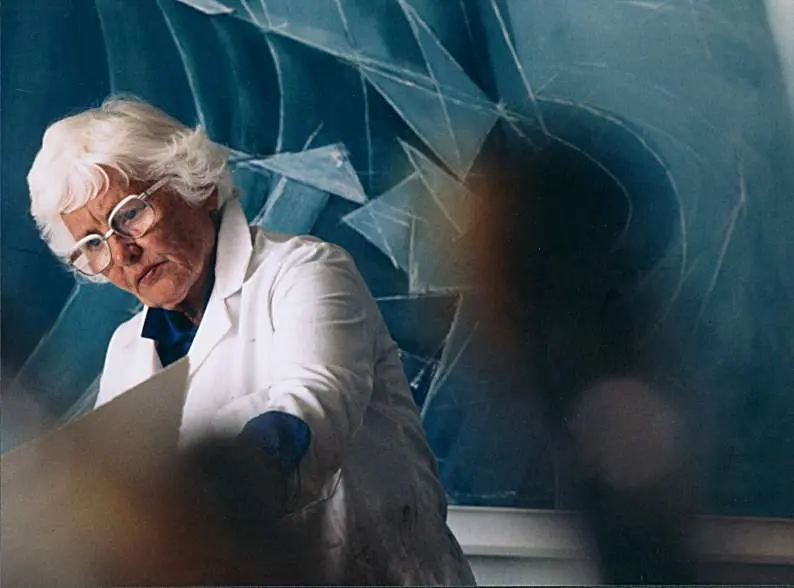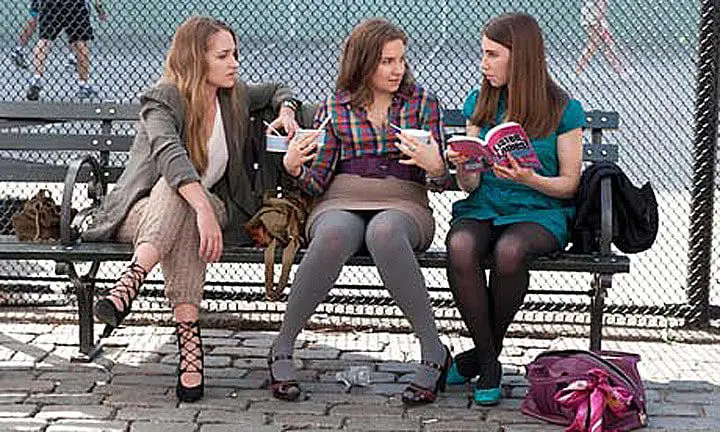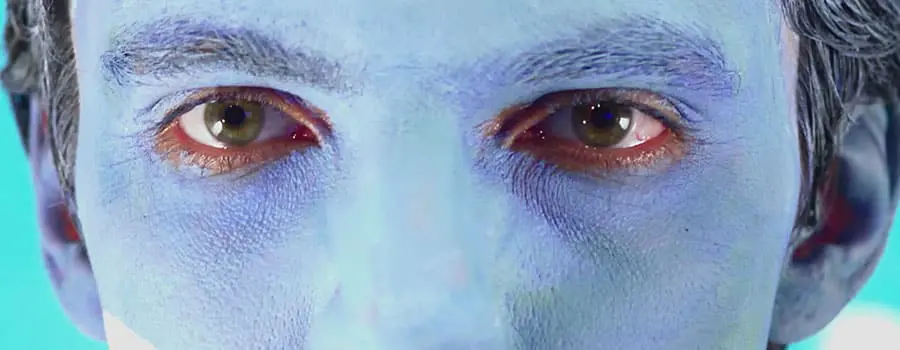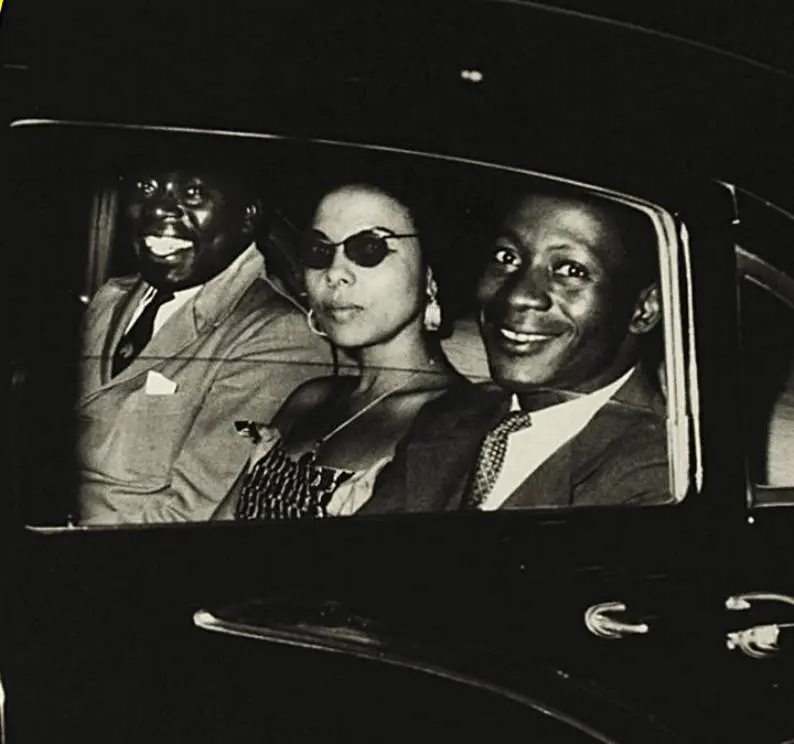Interview by Paul Risker
Mark Cousins’ A Sudden Glimpse to Deeper Things, offers an intimate portrait of the British 20th Century modernist painter Wilhelmina Barns-Graham. Based out of St Ives, Willie, as she became known, was active in the post-war era. Born with synaesthesia, a condition in which the brain runs sensory information through multiple unrelated senses, Willie was able to associate letters, names and people with particular colours. A key moment in Cousins’ documentary focuses on a transformational aesthetic experience, when in 1949, aged 36, she scaled a Swiss glacier.
Tilda Swinton, a regular collaborator and lifelong admirer of Willie’s art, brings the painter’s thoughts from her private diaries to life. Cousins doesn’t recognise his documentary as a biographical or portrait film, instead he describes it as a portrayal of Willie’s visual imagination. A Sudden Glimpse to Deeper Things is not only a reassessment of her place in 20th century art, but explores neurodiversity, ageing and how memories and creative expression transcend time.
A prolific filmmaker and writer, Cousins is most famous for his 2011, fifteen-hour documentary, The Story of Film: An Odyssey. His film-based documentaries also include: A Story of Children and Film (2013), the fourteen-hour long, Women Make Film (2018), The Eyes of Orson Welles (2018) and My Name is Alfred Hitchcock (2018). His 2022 documentary, The March on Rome, looked back on Mussolini’s 1922 march on Italy’s capital to explore film as a propaganda tool, and while preparing for eye surgery, he explored the relationship between sight and the human experience in The Story of Looking (2021).
In conversation with Flux, Cousins discussed the uniqueness of Willie’s perspective, his belief that imagination is concrete, the hope that educational culture is becoming more responsive towards neurodiversity, and how art is not about self-expression.
Where does the energy come from to be as prolific a writer and filmmaker as you are?
It’s a good question, and I think the energy is from basically being a fast person. I don’t sleep a lot, and I was doing a book at the same time as this film—it’s a kind of compulsion I feel. One of the things that attracts me to Willie is she had no off switch and I don’t have much of one either. Often, when I start a new film, I can see it fully formed, and then you have to make it. I think Willie was the same—when she could see a painting in her head, she had to do it.
When Rainer Maria Rilke talks in Letters to a Young Painter, he says if he didn’t do this, he’d die. You have to. I feel bad because I don’t seem to have trouble getting ideas. Werner Herzog famously said the problem isn’t having ideas, it’s managing their assault. It’s similar for me to be honest [laughs].
The Italian director Michelangelo Antonioni never lost the desire to make films. His body may have failed him, but even in old age, his mind and creative spirit sought creative and intellectual expression.
As I’ve seen myself age, I’ve become more interested in ageing, and this film is about that. We start with an old woman, and we look back at how she would have felt about her younger self. And I remember that Frank Lloyd Wright was in his 90s when he designed the Guggenheim.
The film doesn’t take a linear approach, instead it drifts back and forth in time. This emphasises the relationship between ageing and how memory transcends time.
I usually like the beginning to be an echo of the end, but with this one I wanted that idea of it being from a distance. She was distanced from her younger self, and we’re distanced from her because she has been dead twenty years. We’re just seeing the glacier that has almost gone. I wanted to create something quite elegiac towards the end and when you go back to the start you notice what’s missing and what has changed.
We are fascinated by creative personalities—curious to understand who they are beyond their work. Of course, certain individuals like actor Joaquin Phoenix and even Joel and Ethan Coen are reticent about doing interviews. It’s understandable because that mystery has its value.
What’s interesting is, I said to myself I wouldn’t do any biographic or portrait films, and I’ve done five. I think, ‘Oh God, for fucks sake stop it.’ But this isn’t a biographical or portrait film. We learn some things about her life, but I realised a long time ago that what the film portrays is someone’s visual imagination because she left lots of evidence. If you stand in the real world and look at the Swiss Alps, and then look at how she rendered it, you can actually see how her brain refracted it, and that’s proper evidence.
I had access to all the notebooks, and I could see her working methods, so that’s the concrete bit. It’s weird to say that imagination is concrete, but I would argue that it is. In fact, the biographical stuff is more fluid and mysterious and hard to know.
It’s not uncommon for people to create worlds in their imagination as a coping mechanism for anxiety and trauma. These are built from reality, and so imagination is concrete.
If you think about a film like The Wizard of Oz, when Dorothy goes into a dream state; when she goes over the rainbow, it’s more solid. You look at the cinematography and the colours, it’s sharp, whereas the black and white in the Kansas sequence is softer. It’s good to challenge the idea that imagination is invisible or mysterious or not real. We can turn that on its head and that’s when I thought, ‘What if we actually do it like this woman’s visual thinking?’
I’m a visual learner and I recognise that the different ways people learn and process information have been a gradual, if not reluctant progression. It’s important to embrace the diverse ways the human mind works.
Absolutely, and we should capture it because it’s very valuable stuff, as we know. A lot of the engineering schools and football teams are full of people who think visually and have resistance to words.
One of my favourite American writers is Temple Grandin, who is neurodiverse, and her last book was called Visual Thinking. She has influenced education in America and has said to teachers that if they have a child like this, then capture them, because they have their own brilliance which will outshine some of the other people in other areas.
Hopefully, the educational culture around the world understands this better. Certainly, in the area of art history there’s a movement called neuro art history. They’re looking back at some of the most famous artists, Kandinsky, Van Gogh, Leonardo da Vinci, and realising we can understand them differently through the lens of neuroscience.
We must continue to peel away the story of art, to uncover those obscure or lost voices. This challenges the inequality and lack of diversity in creative expression.
That’s true, particularly to your point about who tells the story. As we know, a lot of our history has been written by middle-aged white-neuro-typical men. There are obviously other types of human beings, and so I think her moment has come. The more we’re interested in the environment, feminism and neurodiversity, the more we should look again at artists like Willie and see how valuable she is.
I am fascinated by shapes and forms, and I often question whether others see what I see? I’m also struck by how I am connected to Willie through you. It’s indirect, but it’s like we’re having a conversation.
That’s great, and Willie went to the Alps and didn’t paint the Alps. She went to other famous places and didn’t paint those famous vistas. So, what you are talking about is something Leonardo da Vinci wrote about a long time ago—looking at a wall, you see images and patterns. For example, Willie realised that for her, the number five had a specific colour to it that other people didn’t see. And she thought there’s a whole world which she was seeing that other people aren’t. I think that was a kind of rocket fuel for her and later in life she connected that to certain religious beliefs. She realised the basic sense of a world other people aren’t seeing is a brilliant way to make a picture. And it sounds as if you’ve got some of that too and I certainly feel I have.
An interesting aspect of Willie’s art is her continual evolution. It seems that she never allowed herself to find a comfort zone. Instead, she was always challenging herself creatively.
She kept changing and shifting. When she went to Barcelona in the 90s, and she saw the Olympic Games, her art suddenly changed as a result of that. One of the factors here is fashion. She didn’t try to follow fashion, even though she was doing what would be called modern art, and that was a weakness in a way, because it meant her work wasn’t seen as sexy.
She led an elite lifestyle, and it protected her when fashions changed. When you talk about some artists who have a window of time, that’s often because they’ve hitched their wagon to a certain fashionable thing. So, it’s very admirable that she didn’t try and chase trends.
Even though, as you’ve rightly said, her paintings changed a lot over the years, one constant was drawing. She would always draw. She had her art education in the 30s, and besides drawing a lot of windmills, and no matter how abstract her art became, you’d always find her at some point drawing what was in front of her eyes. And is that not a kind of instinct? ‘There’s something out there, and I’m just going to try and capture it and absorb it. I’m not going to assert myself and be artistic about it—I’ll just draw it.’ I think that fuelled her throughout her life.
In cinema, there’s the idea of creating space for the audience to enter the film. Can this be applied to other art forms, like painting?
That’s an interesting question. I think if you’re dealing with a more narrative-based art form, films for example, then that makes a lot of sense, because sometimes there’s the scene everybody wants to see. And if you leave that out, it leaves a space. I think it’s harder to apply that idea in a painting. She was certainly very interested in space—some of her canvases are very big, and there’s a lot of emptiness in some of her work. I don’t personally think she’d recognise that idea.
What’s clear is she didn’t think of her audience at all. And as a painter, I don’t think you have too as much. I don’t think she ever thought, ‘Will the audience get this? Or like it?’ She didn’t think, ‘Well, the audience expect glacier pictures from me, therefore I will do something else.’ At that stage she was driven more by her own rhythms and unaware of questions about the audience. But to look at it another way, she was very aware of editing things out. So, if that’s like space, then yes. She’d go to a famous place and say I’m not showing that. Maybe that’s another way of saying yes to your question.
If I were to assign an auteurist trait to your filmmaking, it would be to say it’s observational.
That feels right and I feel affected by her. I feel she’s inside of me and I certainly feel an infinity with her. On the question of observation, I think you’re right. I’ve never really believed in the idea that art is about self-expression. I meet a lot of people that have been to film school who think they’ve got this brilliant inner world that they have to break out, and that has always seemed a bit egotistical to me. I always think my job is to notice the outer world and to then shape it into something. To make cinema and observations—I’m happier with that definition of creativity than something that is all about me having a brilliant inner life. I don’t think I have a brilliant inner life, but I’ve got very good eyes.
Would you describe filmmaking as the art of instinct?
It is a language, and it’s like learning French. At a certain point when you’re learning a language, you need to feel it—you have to hear the rhythm, the richness, and the poetics. So, with filmmaking, and in the moment, you have to switch off your rational brain. You have to let the underlying stuff of your irrational brain, your sense of rhythm and your unconscious, and the emotion you spoke about earlier take charge, because those instincts are often good.
A Sudden Glimpse to Deeper Things is in select cinemas across the UK and Eire now. Upcoming dates for the UK Q&A Tour with director Mark Cousins are:
22 October – Falmouth The Poly
23 October – St. Ives The Royal Cinema
24 October – Bristol Watershed
25 October – Belfast Queen’s Film Theatre
29 October – Edinburgh The Cameo
1 November – Stirling Central Documentary Festival
2 November – Dundee DCA (+ Q&A with Mark Cousins)
3 November – Newcastle Tyneside Cinema
7 November – Woodbridge The Riverside (+ video Q&A with Mark Cousins)

